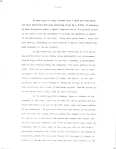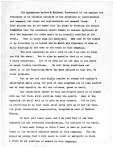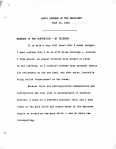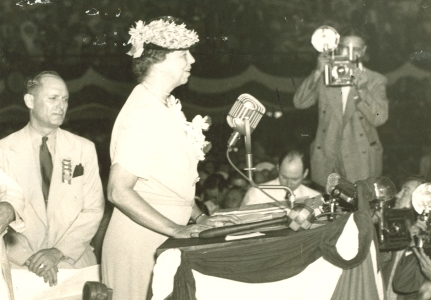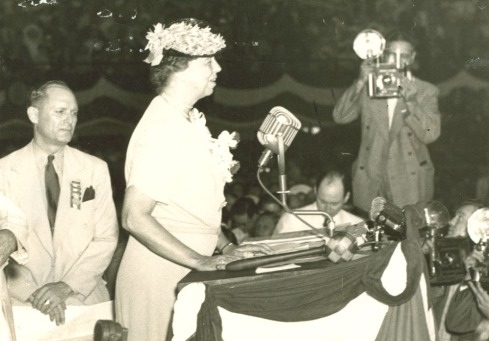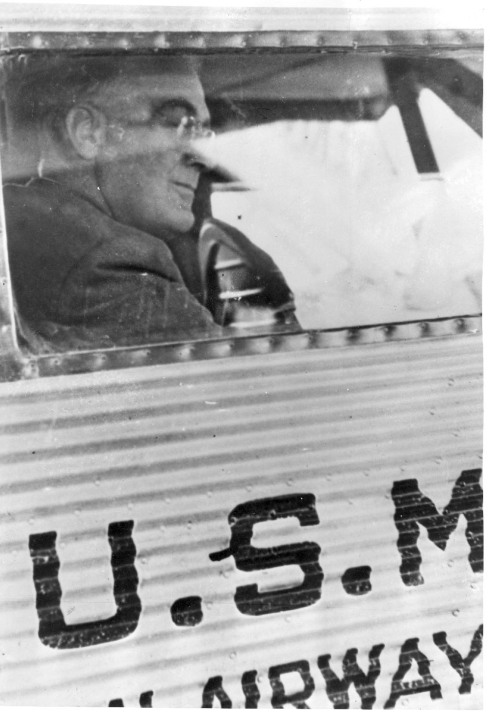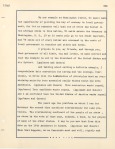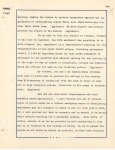You are currently browsing the tag archive for the ‘Democratic National Convention’ tag.
FDR and the Democratic National Convention
“I pledge you, I pledge myself, to a new deal for the American people”
– Franklin D. Roosevelt
This now famous line was uttered by FDR during his acceptance speech at the 1932 Democratic National Convention. FDR was nominated as the Democrat’s presidential candidate four times – 1932, 1936, 1940 & 1944. He made history at the 1932 convention by flying to Chicago to accept the nomination in person – a practice which is still in place today. Aside from those four conventions, FDR also played a role in earlier conventions, and the convention of 1924 marked an important milestone for him and his political career.
1924 – FDR gains national attention
On June 26, 1924 FDR re-entered the public arena at the Democratic National Convention in New York City. Three years before the convention FDR contracted polio, a disease which left him paralyzed from the waist down. Thanks to the work of Louis Howe and Eleanor Roosevelt, FDR was able to stay active in politics while he began his rehabilitation.
In 1924 FDR backed New York Governor Al Smith as the presidential nominee for the Democratic Party, and Smith asked FDR to give his nominating speech at the convention. When on stage, FDR moved to the podium assisted only by his two crutches – a huge feat for him to perform.
In his speech FDR declared Smith to be “The Happy Warrior.” Smith failed to get enough delegates to win the nomination. FDR went on to nominate Smith again at the 1928 convention in Houston. Smith won the Democratic nomination, but lost the presidential election to Herbert Hoover.
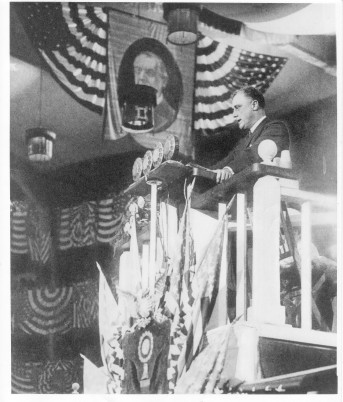
Franklin D. Roosevelt delivers nominating speech for Alfred E. Smith at the Democratic convention, Madison Square Garden, New York, New York. June 26, 1924.
1932 – First nomination for President
The 1932 convention pitted FDR, now governor of New York, against Al Smith and many others. The convention that year was held in Chicago, and after four contentious votes FDR was named as the Democratic nominee for the presidency.
When it came time to accept the nomination, FDR broke with tradition and flew to Chicago to address the convention in person. He acknowledged that fact in the beginning of his speech saying, “the appearance before a National Convention of its nominee for President, to be formally notified of his selection, is unprecedented and unusual, but these are unprecedented and unusual times.”
FDR went on to promise action and relief against the hardships caused by the Great Depression and pledged himself to a “new deal” for all Americans.
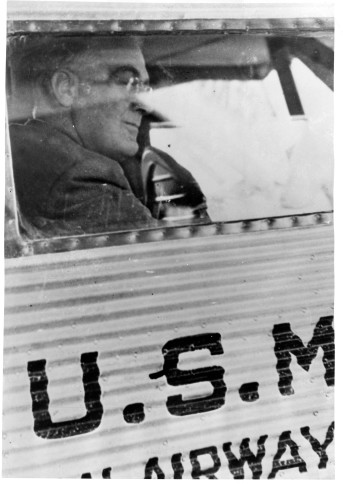
Franklin D. Roosevelt aboard airplane as it refuels in Cleveland, Ohio on his way to Chicago. July 2, 1932.
1936 – First re-election
Philadelphia was the site for the 1936 convention – a convention which was much calmer than that of 1932. FDR and Vice President John Nance Garner were nominated without the need of a roll call, and on June 27th, FDR addressed the convention.
As he spoke, he talked of the need for freedom from tyranny, both political and economic, and of making government the “embodiment of human charity.” FDR went on to say that “there is a mysterious cycle in human events. To some generations much is given. Of other generations much is expected. This generation of Americans has a rendezvous with destiny.”
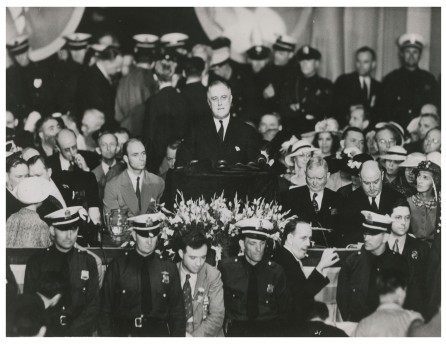
FDR accepts the nomination for the Presidency in speech at Franklin Field, Philadelphia, PA. June 27, 1936.
1940 – An unprecedented third term
1940 brought another convention first. After much speculation, FDR broke with presidential tradition and ran for a third term. While he was easily nominated on the first ballot, the convention was not without some controversy. This time it lay in the nomination of a vice-presidential candidate. The vote came down to two men, Henry Wallace and William Bankhead. FDR was adamant on Wallace being his running mate, but the convention was less convinced.
While FDR did not attend the convention, Eleanor was instead sent to deliver a speech in hopes of bringing together the party. In her address she called for unified action and support for the President. After her speech the convention voted, and Wallace was nominated. For more on Eleanor’s speech, please visit: https://fdrlibrary.wordpress.com/2011/07/21/found-in-the-archives-9/
1944 – A fourth term & final convention
The 1944 convention brought about the unprecedented nomination for a fourth term for FDR. Like the convention in 1940, FDR did not attend this convention. Instead, when the nomination was announced FDR was in California on his way to Hawaii to discuss military strategy for the ongoing war. Even with the easy nomination for FDR, this convention was not without controversy and contention.
Again, the controversy centered on the vice presidential nomination. By 1944 FDR’s health was steadily declining, and many delegates were opposed to Henry Wallace becoming FDR’s possible successor. Harry Truman was proposed as the vice presidential candidate, and though FDR knew little about Truman, he agreed to Truman’s nomination for the sake of party unity.
July 18, 1940: FDR was nominated for an unprecedented third term as president.
ER addressing the Democratic National Convention in Chicago.
July 18, 1940
FDR Library Photo Collection. NPx. 69-96.
**********
Did you know:
- On July 18, 1939 FDR released a public statement on the necessity of revision of the neutrality laws, saying that failure to do so “…would waken the leadership of the United States in exercising its potent influence in the cause of preserving the peace among the nations in the event of a new crisis in Europe between now and next January.”
- On July 20, 1944 FDR was renominated for president, becoming the first president nominated for a fourth term.
July 2, 1932: FDR accepts the Democratic Party nomination for president at the convention in Chicago; declaring “a New Deal for the American people.”
Franklin D. Roosevelt en route from Albany to Chicago to address the Democratic National Convention and accept the nomination for President.
July 2, 1932
FDR Library Photo Collection. NPx. 61-238.
**********
Did you know:
- On July 5, 1934 FDR landed in Cap Haitien, Haiti becoming the first president to visit Haiti while in office.
- On July 4, 1940 FDR turned over his repository of personal and official papers at the FDR Library in Hyde Park to the government.
July 18, 1940: FDR was nominated for an unprecedented third term as president.
ER addressing the Democratic National Convention in Chicago.
July 18, 1940
FDR Library Photo Collection. NPx. 69-96.
**********
The New Deal Estore is a great place to shop for Roosevelt related books, gifts, and other treasures from the New Deal Store at the Roosevelt Library. Available at www.fdrlibrary.marist.edu, the Estore features everything from a selection of the latest books on the Roosevelts and their times, to T-shirts, ties and caps, multimedia, campaign memorabilia, and museum replicas. For items related to this week’s blog post, follow the links below:
Freedom from Fear 1929-1945 by David M. Kennedy
Franklin D. Roosevelt, A Rendezvous with Destiny by Frank Freidel
Commander in Chief – Franklin Delano Roosevelt, His Lieutenants, and Their War by Eric Larrabee
July 2, 1932: FDR accepts the Democratic Party nomination for president at the convention in Chicago; declaring “a New Deal for the American people.”
Franklin D. Roosevelt en route from Albany to Chicago to address the Democratic National Convention and accept the nomination for President.
July 2, 1932
FDR Library Photo Collection. NPx. 61-238.
**********
The New Deal Estore is a great place to shop for Roosevelt related books, gifts, and other treasures from the New Deal Store at the Roosevelt Library. Available at www.fdrlibrary.marist.edu, the Estore features everything from a selection of the latest books on the Roosevelts and their times, to T-shirts, ties and caps, multimedia, campaign memorabilia, and museum replicas. For items related to this week’s blog post, follow the links below:
1934: A New Deal for Artists by Ann Prentice Wagner
FDR’s Alphabet Soup, New Deal America 1932-1939 by Tonya Bolden
Franklin D. Roosevelt and the New Deal by William E Leuchtenburg
Nature’s New Deal by Neil M. Maher
The Coming of the New Deal, the Age of Roosevelt by Arthur M. Schlesinger Jr.

